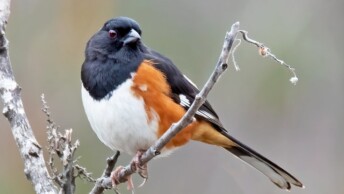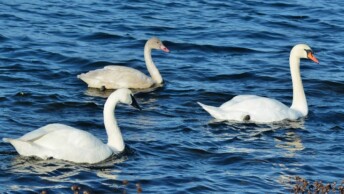Brood parasitism in birds is a strategy where one species lays its eggs in the nest of another, leaving incubation and chick-rearing to an unsuspecting host. The most familiar examples are the common cuckoo in Europe and the brown-headed cowbird in North America, both of which have become symbols of this unusual lifestyle.
There are several forms of brood parasitism. Obligate parasites never build nests of their own, relying entirely on hosts for reproduction. Facultative parasites sometimes raise their own young but also lay eggs in other birds’ nests. Some species parasitize their own kind (intraspecific parasitism), while others target different species (interspecific parasitism). These strategies have evolved independently in multiple bird families and occur in more than a hundred species worldwide.
Common Cuckoo
Cuculus canorus
- Type of parasitism: Obligate, interspecific.
- Typical behavior: Egg mimicry, early hatching, chick eviction, brood-like begging calls.
- Host selection: Broad generalist – many small insect-eating passerines (e.g., pipits, reed warblers, wagtails, robins).
- Where found: Across the Palearctic in woods, scrub, meadows, and reedbeds.
- Conservation status: Least Concern; widespread, with regional declines tied to agricultural change and climate mismatch with hosts.
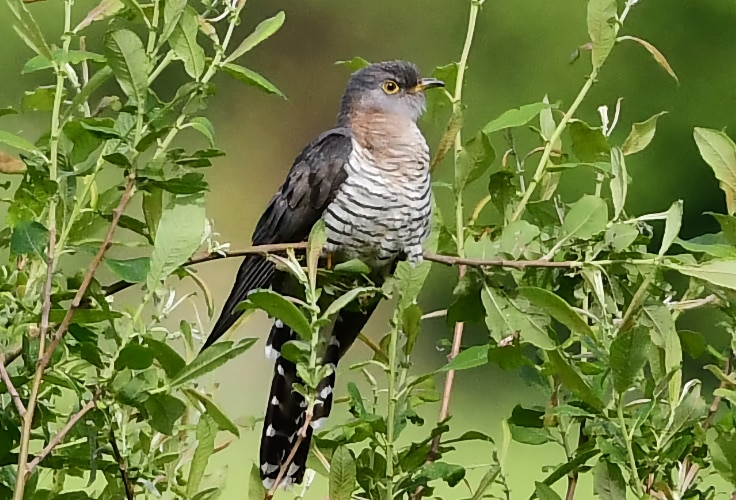
The common cuckoo is the emblem of brood parasitism. It is famous for laying eggs that resemble those of its hosts and for chicks that push rivals out of the nest. Female lineages (“gentes”) specialize on different hosts, which explains the wide variety of egg colors and patterns across the species. Its long history with European songbirds has made it central to research on mimicry and host defenses.
From exposed perches, females watch for fresh nests and lay just as hosts begin their clutches. They can delay laying slightly so the embryo develops early, ensuring the chick hatches ahead of its nestmates. Many eggs are excellent imitations of the chosen host’s eggs. In some nests, several cuckoo eggs accumulate; females often remove one egg before adding their own. After hatching, the chick ejects host eggs or nestlings and monopolizes care. Nestling calls adapt to mimic the sound of a full brood, persuading foster parents to provide heavy feeding. The cuckoo exploits an extraordinary variety of hosts – well over 100 species regularly, and nearly 300 in total, with pipits, reed warblers, wagtails, and robins among the most frequent.
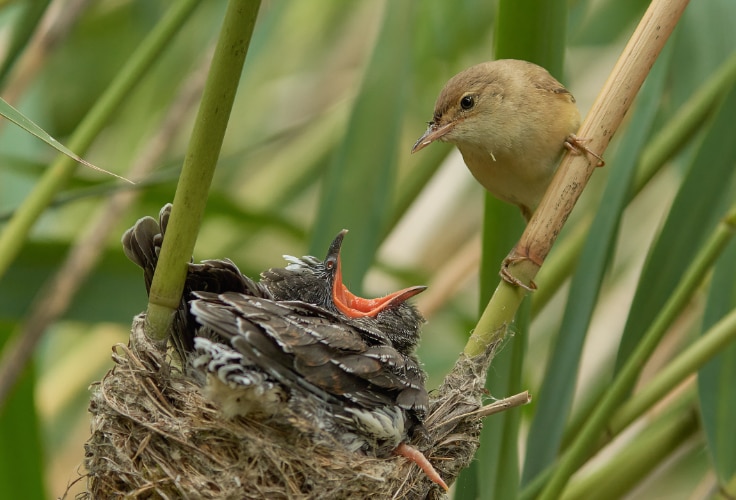
Hosts respond in diverse ways. Adults may mob an intruding cuckoo, and many species eject mismatched eggs, bury them under new nesting material, or desert the clutch altogether. Rejection depends on how closely the cuckoo egg matches the host’s. Ground-nesting birds are generally less likely to reject than tree- and shrub-nesters. Species with a long evolutionary history of parasitism, such as redstarts, are typically more skilled at spotting foreign eggs than species like dunnocks, which are relatively new hosts.
This species breeds across much of the Palearctic in woodland, scrub, meadows, and reedbeds, and uses varied open and semi-open habitats during migration. It remains widespread, though declines in northern Europe are linked to intensive farming that reduces insects and host numbers, and to climate-driven mismatches in timing between cuckoos and their hosts. Protecting traditional, host-rich habitats and monitoring the effects of climate change are important for its future.
Brown-Headed Cowbird
Molothrus ater
- Type of parasitism: Obligate, interspecific.
- Typical behavior: Rapid egg-laying, early hatching, chick dominance, nest destruction.
- Host selection: Extremely broad; over 220 species parasitized, more than 140 confirmed hosts.
- Where found: Across North America; favors grasslands, forest edges, agricultural areas, suburbs.
- Conservation status: Least Concern; widespread and common, though locally managed to protect vulnerable species.

The brown-headed cowbird is North America’s most familiar brood parasite, known for laying its eggs in the nests of an exceptionally wide range of other species. This generalist strategy, combined with its abundance, has made it a central subject of research on brood parasitism and a serious conservation concern for vulnerable songbirds, including the endangered Kirtland’s warbler.
Female cowbirds locate nests by watching from perches, walking through host territories, or flushing birds with noisy movements. They typically lay quickly, often removing or puncturing a host egg in the process, and may add several eggs to the same nest. Cowbird eggs hatch sooner than host eggs, giving the chick an advantage. The nestling grows fast, competes aggressively, and can smother or eject nestmates. Foster parents feed cowbird chicks at high rates, often to the detriment of their own young. The species has been recorded in the nests of more than 220 birds, with over 140 confirmed to raise cowbirds. A single female may lay dozens of eggs in a season, sometimes up to 40.
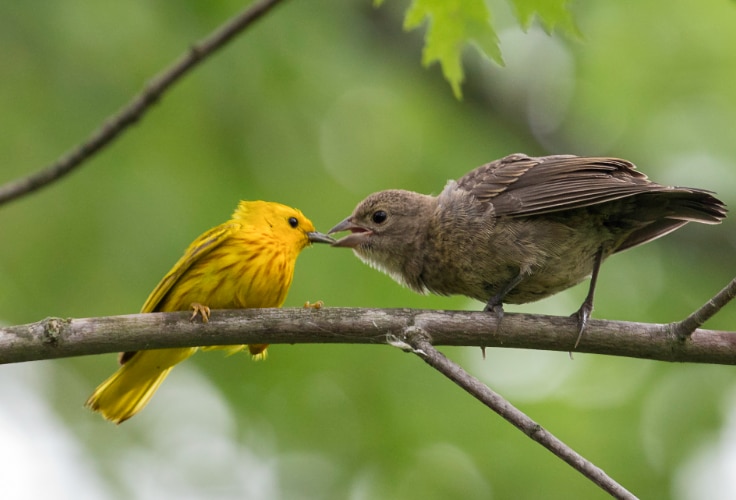
Responses to cowbird parasitism differ among hosts. Some, like yellow warblers, build a new nest over the old clutch. Others, such as brown thrashers and gray catbirds, physically eject cowbird eggs. Many species, however, do not recognize them at all. In rare cases, cowbirds retaliate: if their eggs are removed, they may return to destroy the host’s clutch or nest, a “mafia” behavior that can force acceptance. Hosts can also suffer from the loud begging of cowbird nestlings, which attracts predators, or from reduced care to their own chicks.
This species is found across North America in open and semi-open habitats: grasslands, forest edges, farmland, and suburbs. Once tied closely to bison herds on the Great Plains, cowbirds expanded widely with agriculture and forest clearing. Today they remain common and adaptable, though their parasitism continues to impact certain declining songbirds. Local control efforts are used where endangered hosts are especially vulnerable.
Great Spotted Cuckoo
Clamator glandarius
- Type of parasitism: Obligate, interspecific.
- Typical behavior: Early hatching, intense begging, chemical defense in chicks.
- Host selection: Primarily corvids; also starlings and other open-nesters in Africa.
- Where found: Southern Europe, Middle East, and widely across sub-Saharan Africa in semi-arid woodlands and scrub.
- Conservation status: Least Concern; large range and stable population.
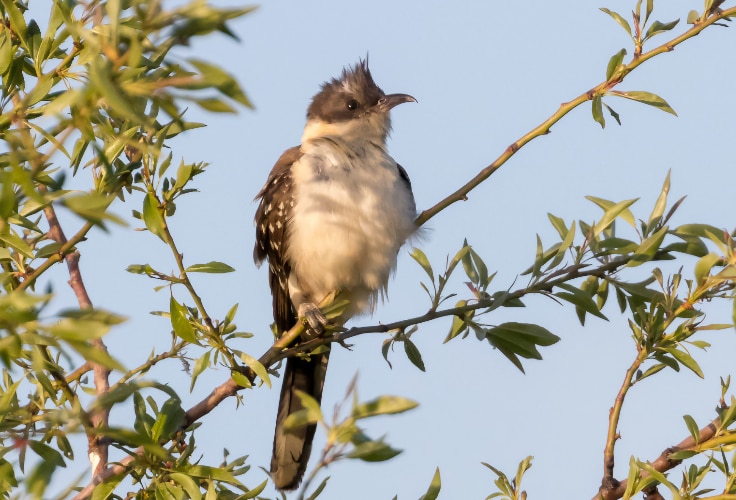
The great spotted cuckoo is one of the best-studied brood parasites, especially for its relationship with magpies and crows. Unlike the common cuckoo, it does not evict host eggs or chicks, but instead relies on its faster growth, intense begging, and longer dependence on foster care. This species has drawn attention not only for its parasitic strategy but also for unexpected cases where hosts may gain some benefit from raising a cuckoo chick.
Females target mainly corvid nests, especially Eurasian magpies and carrion crows in Europe and pied crows in Africa, but they also use a range of starlings and other hole- or open-nesting birds. Eggs hatch before those of the hosts, and chicks demand large amounts of food, often outcompeting host nestlings. Studies show cuckoo chicks receive more food and grow faster than magpie or crow nestlings. They may remain dependent on foster parents for weeks after fledging, particularly because their diet often includes hairy caterpillars that are difficult for young birds to handle alone.
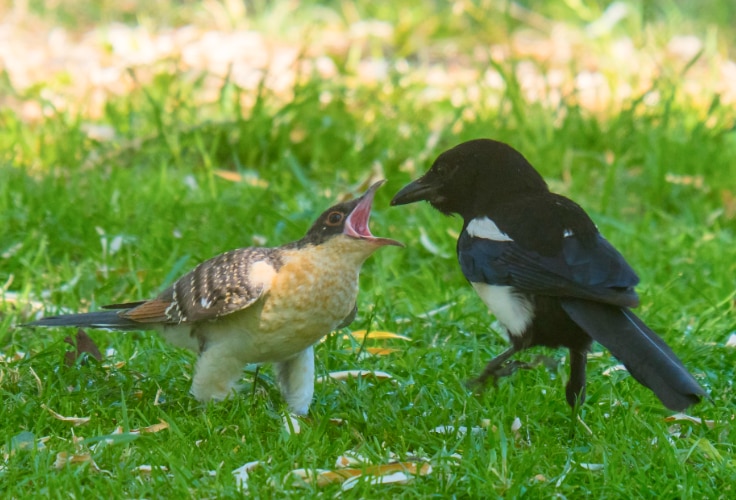
Parasitism by this cuckoo brings both costs and unexpected benefits. Host chicks may starve when they cannot compete with the parasite, but the cuckoo chick can also secrete a foul-smelling substance when threatened, which deters predators and sometimes protects host young as well. In heavily predated areas, crow chicks actually survive better when sharing a nest with a cuckoo, though in safer areas the presence of a cuckoo is mostly harmful.
This species breeds across southern Europe, the Middle East, and much of Africa, favoring dry woodlands, thorn scrub, rocky hillsides, and savanna-like landscapes. Northern and southern populations migrate to tropical Africa for the non-breeding season, while some remain year-round in parts of southern Spain and South Africa. Overall, the great spotted cuckoo remains widespread and stable, though local threats include hunting, road collisions, and predation by raptors such as Eleonora’s falcon.
Asian Koel
Eudynamys scolopaceus
- Type of parasitism: Obligate, interspecific.
- Typical behavior: Rapid laying, early hatching, occasional egg removal, chicks raised alongside hosts.
- Host selection: Medium to large passerines, especially crows, mynas, and starlings.
- Where found: Indian Subcontinent to China, Southeast Asia, and the Sunda Islands; favors woodlands, orchards, plantations, and city parks.
- Conservation status: Least Concern; widespread and stable, often thriving in human-modified habitats.

The Asian koel is one of the most familiar brood-parasitic birds of South and Southeast Asia, easily recognized by the male’s ringing “ko-el” call that echoes through city parks and rural groves. Its long cultural presence is reflected in Sanskrit texts and folklore, where it was celebrated for its song and even described as Anya-Vapa – “that which was raised by others,” likely the earliest written reference to brood parasitism. Unlike many cuckoos, it is also notable for being largely frugivorous as an adult, a diet that may shape aspects of its breeding biology.
Females lay eggs in the nests of a wide range of medium and large passerines, with crows, mynas, starlings, orioles, shrikes, and laughingthrushes among the most common hosts. They often deposit eggs soon after the host’s first, sometimes removing one in the process. Koel eggs hatch in 12-17 days, usually two or three days before the host chicks. Nestlings do not always evict their foster siblings, and broods often include both host young and koel chicks, though the parasite usually monopolizes care and food. Multiple females may lay in the same nest, resulting in several koel chicks raised together. In some cases, female koels have been observed feeding their own young in crow nests, though such behavior is rare.

Hosts vary in their defenses. Crows are relatively tolerant, with low rejection rates, while species such as the long-tailed shrike reject model koel eggs at high frequencies. Even where hosts accept them, parasitism reduces breeding success through egg loss, delayed hatching, or starvation of host chicks. Shifts in host use are also documented: in parts of Thailand and the Malay Peninsula, koels switched from crows to mynas as the latter became more common. Such flexibility likely explains their success across diverse regions.
The species ranges widely from the Indian Subcontinent through China and Southeast Asia to the Philippines and the Sundaic Islands, with northern populations migrating south in winter. It occupies open woodlands, forest edge, plantations, orchards, mangroves, and city parks, and remains common even in heavily altered landscapes. Its range is still expanding in parts of Southeast Asia, aided by the spread of host species such as house crow and common myna, making it one of the most adaptable brood parasites.
Village Indigobird
Vidua chalybeata
- Type of parasitism: Obligate, interspecific.
- Typical behavior: Host song mimicry, imprinting on foster species, egg-laying in host nests without egg destruction.
- Host selection: Primarily red-billed firefinch; also brown firefinch and occasionally other estrildid finches.
- Where found: Widespread in sub-Saharan Africa; favors open woodland, savanna, scrub, farmlands, and villages.
- Conservation status: Least Concern; fairly common, locally numerous, and often associated with human settlements.
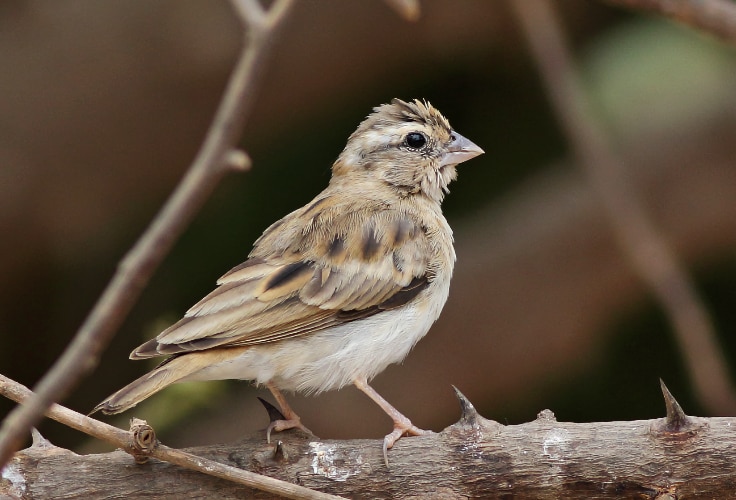
The village indigobird is a striking brood parasite of Africa, best known for its extraordinary reliance on mimicry and imprinting. Males sing elaborate repertoires that closely copy the songs of their foster parents, usually red-billed and brown firefinches. Females, in turn, select mates based on these mimicry songs and lay in nests of the same host species they were raised by, a cycle that tightly links parasite and host. This behavior has made indigobirds a model for understanding how host associations can drive speciation.
Females parasitize firefinch nests during the building or laying period, often after following the hosts to their concealed grass nests. They typically lay two to four white eggs, slightly larger than the host’s, without removing or destroying host eggs. Incubation lasts 11-12 days, with indigobird chicks hatching alongside host young. Nestlings resemble firefinch chicks in gape markings and mouth coloration, ensuring they are fed. Unlike many cuckoos, indigobird young are raised together with host nestlings, though they may compete strongly for food. A female can lay over 20 eggs per season, sometimes with multiple females depositing in the same nest.

Host responses are limited because of the close mimicry. Firefinch parents usually accept indigobird eggs and nestlings, and continue to rear mixed broods. Studies show that while parasitism reduces host reproductive success, the overall impact on firefinch populations is moderate compared to cuckoo-like systems. Experiments confirm that imprinting on foster parents determines not only female host choice but also male song mimicry, reinforcing tight coevolution between parasite and host. Occasional mimicry of alternative firefinch species has been observed, suggesting that switches in host association may underlie the diversification of indigobird species.
The species is widespread across sub-Saharan Africa, found in open woodlands, savannas, farmlands, and even villages and gardens where firefinches thrive. It often forages close to people, feeding on grass seeds and roosting in dense trees. Locally it can be numerous, with high parasitism rates reported in parts of West and Southern Africa. Populations appear stable, and the bird readily adapts to human-modified habitats, making it one of the most successful and widespread members of the indigobird group.
Pin-Tailed Whydah
Vidua macroura
- Type of parasitism: Obligate, interspecific.
- Typical behavior: Egg-laying in finch nests, nestling gape mimicry.
- Host selection: Primarily waxbills, also other estrildid finches such as mannikins and silverbills.
- Where found: Sub-Saharan Africa in grassy and shrubby habitats, farmland, gardens, and villages; introduced to Puerto Rico.
- Conservation status: Least Concern; widespread and locally common, with range expansion linked to human-modified habitats.
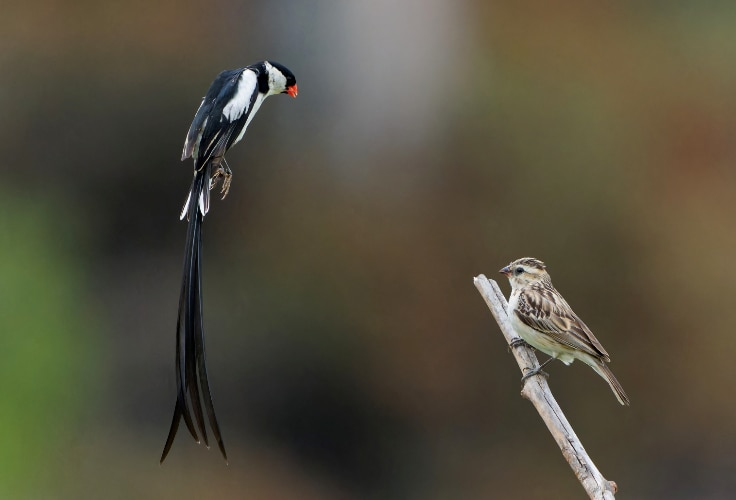
The pin-tailed whydah is one of the most striking brood parasites in Africa, known for the male’s long streaming tail feathers and conspicuous display flights during the breeding season. Singing males hold territories where they perch and hover to attract females, performing dramatic tail-bobbing flights and chattering calls. Multiple females may visit and mate with a single male, while females themselves may mate with more than one partner in a short span. This showy breeding system makes the species highly visible, even in human-dominated landscapes.
Females lay their eggs in the nests of waxbills and other small estrildid finches. They typically enter the nest when the hosts are away, sometimes removing an egg before laying. Whydahs add two to four eggs per nest, which are plain white and slightly larger than the host’s. Incubation lasts about 11 days, and the chicks hatch alongside the host young. Nestlings show intricate mouth markings and gape papillae that mimic their foster siblings, ensuring they receive adequate feeding. Unlike many cuckoos, whydah chicks do not evict or kill host young, and both species often fledge together. Females can lay 20 or more eggs per season, sometimes depositing in the same host nest as other females.
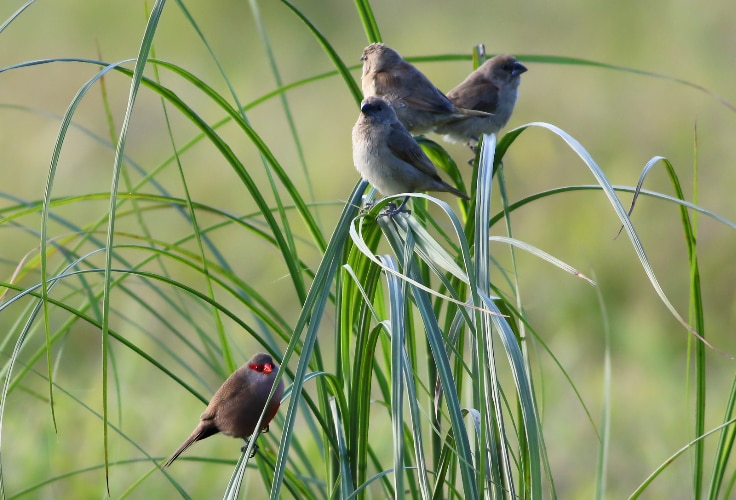
Because of the nestling mimicry, host finches generally accept whydah eggs and chicks. Parasitism reduces the reproductive success of host species somewhat, but overall impact is less severe than in systems with egg rejection or chick eviction. Studies suggest that fledging success of whydahs is lower than that of waxbills, which limits the burden on host populations. The close resemblance between parasite and host young highlights the role of imprinting and coevolution in the whydah-waxbill relationship.
The pin-tailed whydah is widespread across sub-Saharan Africa in open and semi-open habitats, including grasslands, scrub, agricultural fields, gardens, and villages. It often flourishes near people, feeding on grass seeds and roosting in communal flocks. Its distribution has expanded in the past century, partly due to irrigation and the spread of its main host, the common waxbill. The species has also been introduced to Puerto Rico, where it parasitizes introduced estrildid finches. Adaptable and conspicuous, the pin-tailed whydah is both a familiar sight in African landscapes and a successful invader abroad.
Greater Honeyguide
Indicator indicator
- Type of parasitism: Obligate, interspecific.
- Typical behavior: Egg puncturing, chick equipped with bill hooks to kill nestmates.
- Host selection: Wide range of cavity- and enclosed-nesting birds, including bee-eaters, kingfishers, and woodpeckers.
- Where found: Across sub-Saharan Africa in woodlands, savannas, bushland, and gardens, often near bees’ nests.
- Conservation status: Least Concern; fairly common and widespread, adaptable to varied habitats.

The greater honeyguide is notorious as one of the most virulent brood parasites. Unlike its famous role guiding humans to wild honey, it is equally remarkable for its harsh breeding strategy. Females lay their eggs in the nests of a wide variety of cavity- or cup-nesting birds, from bee-eaters and kingfishers to woodpeckers, hoopoes, and starlings. Each egg is laid in a separate host nest, and a single female may produce up to 20 in a season.
The laying female often punctures or destroys the host’s eggs before departing, ensuring her chick faces less competition. Honeyguide nestlings hatch early and are armed with sharp bill hooks, which they use to wound or kill host chicks soon after hatching. These hooks are lost after about two weeks, by which time the young parasite is usually the sole survivor, monopolizing all parental care. This lethal combination of egg puncturing and chick aggression makes the greater honeyguide one of the most destructive avian parasites.
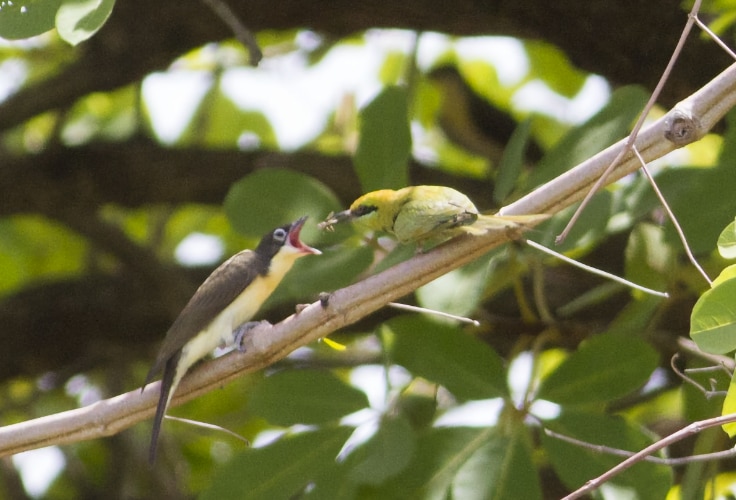
Hosts do not accept this fate passively. Many mob adult honeyguides near their nests, and some, such as Little Bee-eaters, may desert entire clutches once parasitized. Yet experiments show that the presence of a parasite near the nest alone is not enough to trigger egg rejection, and defenses vary widely among species. This cycle of egg destruction by females and chick aggression, met with host strategies such as clutch rejection or desertion, represents one of the most intense examples of coevolution between parasite and host.
The species is widespread across sub-Saharan Africa, from the Sahel to southern Africa, in woodlands, thickets, bushland, plantations, and even gardens and village edges. It often occurs near bee colonies, reflecting its well-known association with honey hunting. Despite its violent parasitic strategy, the greater honeyguide is common and adaptable, maintaining stable populations across a wide range of habitats.
Black-Headed Duck
Heteronetta atricapilla
- Type of parasitism: Obligate, interspecific.
- Typical behavior: Lays in nests of other birds; ducklings leave nest shortly after hatching, imposing no post-hatching cost on hosts.
- Host selection: Generalist, but mainly coots, rosy-billed pochard, and occasionally grebes, gulls, raptors, rails, and ibises.
- Where found: Temperate wetlands of Chile, Argentina, Uruguay, Paraguay, and southern Brazil.
- Conservation status: Least Concern; fairly common and widespread, though dependent on a few abundant hosts.
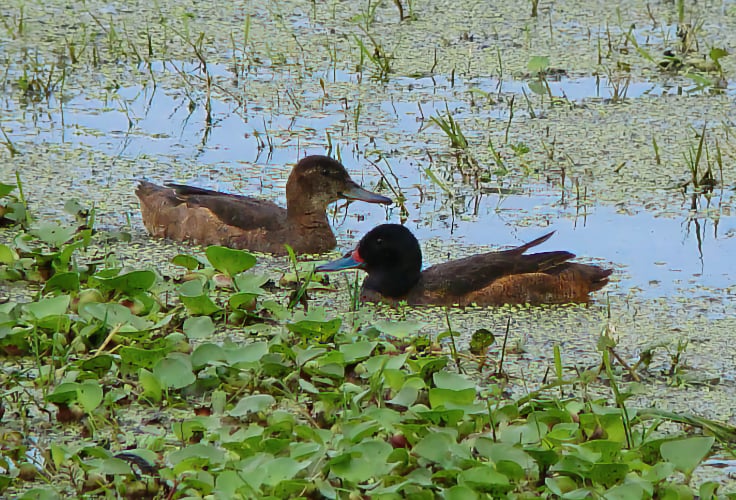
The black-headed duck is unique among waterfowl and indeed among all brood parasites: it is the only species whose young are precocial and independent soon after hatching. Females never build nests but lay their eggs in those of other species, relying entirely on them for incubation. Once hatched, the ducklings leave their foster parents within a day or two and require no further care. This system makes the species a singular case of brood parasitism focused exclusively on incubation.
Eggs are placed in the nests of a wide range of species, including ducks, coots, grebes, rails, gulls, ibises, and even larger birds such as storks – and exceptionally, kites and harriers. However, field studies show that in practice the duck relies heavily on just a few hosts, particularly red-fronted and red-gartered coots, and the rosy-billed pochard. Females usually deposit a single egg per nest, sometimes after removing or damaging a host egg. Incubation lasts about 24-25 days, after which the ducklings quickly leave. Some follow host broods briefly before striking out on their own, but within days they are entirely independent.
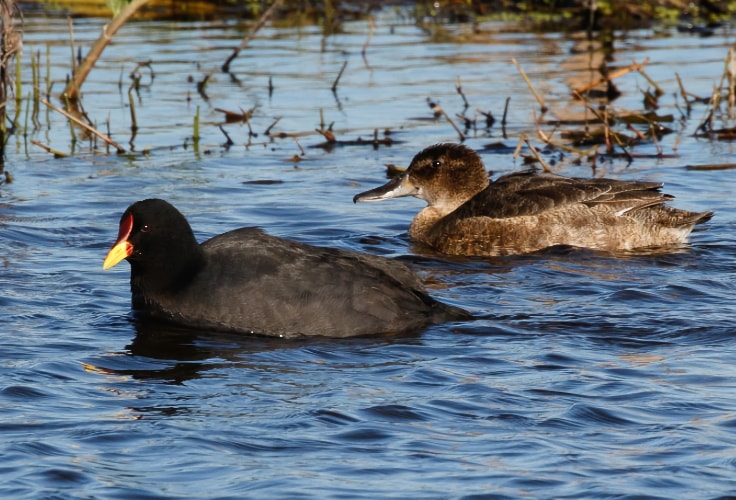
Hosts sometimes reject or neglect black-headed duck eggs, and hatching success can be relatively low, often under 30% in coot nests. Nevertheless, because ducklings leave so soon after hatching, the long-term cost to host species is minimal compared with cuckoos or cowbirds. This unusual dynamic – hosts providing incubation only, with no burden of feeding, has drawn attention from evolutionary biologists seeking to understand how brood parasitism can evolve in precocial birds. The reliance on a small number of abundant host species may reflect both ecological opportunity and the heavy nest predation pressures in South American marshes, which favor species that secure incubation without investing in vulnerable nests of their own.
The black-headed duck inhabits large freshwater marshes dominated by tall sedges such as Scirpus. It is found from central Chile east across Paraguay and Uruguay to northern Argentina and southernmost Brazil, with partial seasonal movements. Outside the breeding season, it uses lakes, ditches, and flooded fields. Although never abundant, it is widespread and adaptable within its wetland range. Populations appear stable but its dependence on a few key host species underscores its unusual ecological niche.
Screaming Cowbird
Molothrus rufoaxillaris
- Type of parasitism: Obligate, interspecific.
- Typical behavior: Egg puncturing, multiple females laying in one nest, nestling and fledgling mimicry.
- Host selection: Primarily grayish baywing; occasionally chopi blackbird and brown-and-yellow marshbird.
- Where found: Southern South America, from Bolivia and Brazil to Uruguay and northern Argentina.
- Conservation status: Least Concern; locally common, populations stable.

The screaming cowbird is a specialist brood parasite of the grayish baywing, a relationship first recognized in the 19th century when naturalists observed young “baywings” molting into screaming cowbird plumage. This remarkable case of mimicry extends from eggs to chicks: parasitic young closely resemble baywing nestlings in appearance and calls, deceiving foster parents and their helpers. The strategy is so effective that nearly all baywing nests across much of Argentina are parasitized, often with several cowbird eggs deposited by multiple females.
Eggs are typically laid during the host’s laying period, when they are most likely to be accepted. Those laid too early are often ejected or abandoned by the baywings, which can recognize nests overloaded with foreign eggs. Females may also puncture host and parasite eggs, reducing competition for their own young. Once hatched, screaming cowbird nestlings develop with their foster siblings but outcompete them through more intense begging calls, which ensure frequent feeding. This close resemblance at every stage has made the screaming cowbird the only brood parasite known to exhibit such detailed chick mimicry.
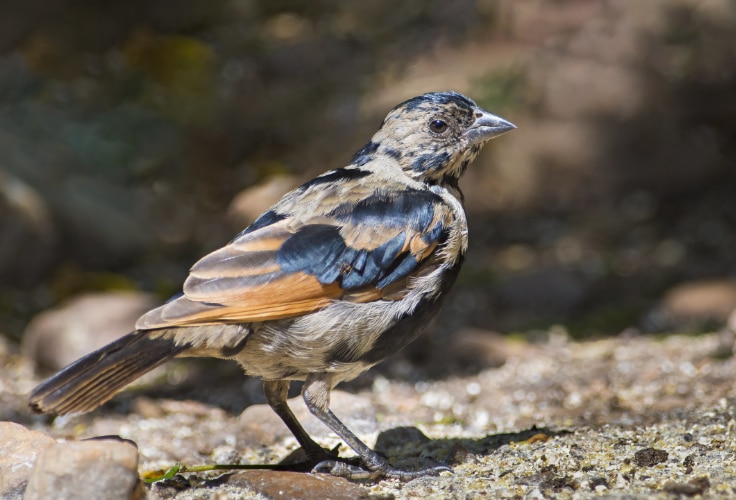
Hosts respond with a range of defenses. Baywings sometimes eject foreign eggs, destroy whole clutches, or abandon parasitized nests altogether, while prolonging the interval between nest-building and egg-laying may help reduce the risk of parasitism. Other host species, such as chopi blackbirds and brown-and-yellow marshbirds, generally do not reject eggs and may raise screaming cowbird chicks where baywings are absent or scarce. Despite high parasitism rates, baywings still manage to raise some of their own chicks alongside the parasite.
The screaming cowbird occurs in open and semi-open habitats across southern South America, from Bolivia and southern Brazil through Paraguay, Uruguay, and northern Argentina. It frequents fields, pastures, scrub, and agricultural lands, often near towns. Though not as numerous as the shiny cowbird, it can be locally common, and its population appears stable. Its tight ecological link with the grayish baywing and its remarkable nestling mimicry make it one of the most specialized brood parasites known.
Parasitic Weaver
Anomalospiza imberbis
- Type of parasitism: Obligate, interspecific.
- Typical behavior: Egg mimicry, host egg removal, chick competition.
- Host selection: Mainly prinias and cisticolas; dozens of small grass-nesting warblers targeted.
- Where found: Patchy distribution across sub-Saharan Africa, from West Africa to Ethiopia, East and southern Africa.
- Conservation status: Least Concern; widespread but local and uncommon.
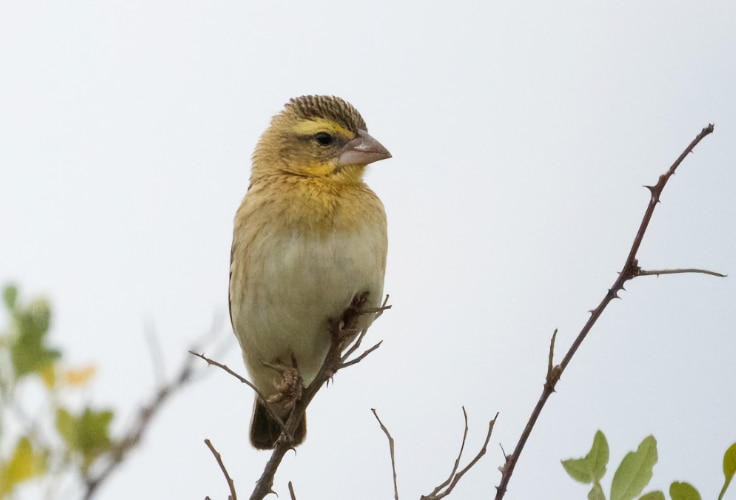
The parasitic weaver, also known as the cuckoo-finch, is a small African songbird whose entire breeding cycle depends on deceiving other birds. Unlike other weavers, it never builds a nest, instead laying its eggs in the domed or sewn grass nests of prinias and cisticolas. This strategy has fascinated researchers because of the intense evolutionary struggle it provokes, with hosts and parasite locked in a cycle of adaptation and counter-adaptation.
Females lay single eggs in multiple host nests, removing or destroying host eggs to improve the odds for their own young. Their eggs often resemble those of the hosts, coming in various shades and patterns – bluish-white, pinkish with spots, or speckled. Yet mimicry is imperfect, and hosts have evolved defenses. Studies on tawny-flanked prinias show “chase-away evolution,” where parasites evolve to better match host eggs while hosts rapidly change their own egg appearance to escape mimicry. Once hatched, parasitic weaver chicks differ visibly from host young but still manage to secure all food by outcompeting or eliminating nestmates. Host chicks rarely survive alongside them.

Hosts sometimes attack or chase away adult parasitic weavers near their nests, and some reject foreign eggs, but defenses vary between species. Occasionally, two parasitic weaver chicks fledge together, though usually they monopolize care. This constant tug-of-war between parasite and host provides one of the clearest living examples of rapid coevolution in birds.
The species occurs patchily across sub-Saharan Africa, from the Gambia and Nigeria to Ethiopia, East Africa, and south to South Africa. It inhabits grassy savannas, floodplains, meadows, rice fields, and shrubland – always near the small warblers it depends on. Though never abundant, it is locally common where hosts thrive, but can be affected by habitat change and trapping for the cagebird trade.
Redhead
Aythya americana
- Type of parasitism: Facultative; interspecific and intraspecific.
- Typical behavior: Nest‐dumping into other ducks’ clutches, forceful intrusions at active nests.
- Host selection: Canvasback is the primary host where they overlap; also many dabbling and diving ducks.
- Where found: North America; breeds in Prairie Pothole and western marshes; winters mainly on the Gulf of Mexico, especially the Laguna Madre seagrass bays.
- Conservation status: Least Concern; overall stable with regional declines; sensitive to wetland loss, western drought, and disturbance, but aided by habitat restoration and management.

The redhead is unique among North American ducks for the extent of its facultative brood parasitism. Females switch among strategies across years – laying their own clutch, “topping up” others before nesting themselves, or going fully parasitic. This flexibility, together with dense winter concentrations on the Laguna Madre and popularity with hunters, makes the species notable in both research and management.
Parasitic tactics are hands-on. Females search along emergent cover, shadow hosts back to nests, and often lay even while the host sits. Intrusions can involve shoving or wedging under the host to reach the clutch; eggs may be added during the host’s laying or incubation. Where ranges overlap, Canvasback is the primary host, but redheads also lay in the nests of mallards, pintails, teal, shovelers, wigeon, scaup, ring-necked ducks, and ruddy ducks, and they frequently dump eggs in the nests of their own species. The timing and intensity of parasitism track water levels: in good water years parasitism peaks early; in poor years it peaks late or replaces typical nesting. Success varies widely, but in some regions canvasbacks raise a substantial share of redhead ducklings.

Host responses range from fierce defense to tolerance. Intrusions can trigger prolonged struggles, with host eggs cracked, buried, or rolled into the water; ovulation in hosts may be suppressed, reducing clutch size. Parasitism is linked to more nest abandonment in several studies and to depressed clutch size or egg success in some hosts (e.g., gadwall, teal, cinnamon teal, and sometimes canvasback), though effects on nest success are mixed across species and sites. Conspecific dumping commonly enlarges redhead clutches but lowers egg success as intruded eggs accumulate. Redhead nests themselves are sometimes parasitized by other ducks and by American coot, complicating outcomes.
Redheads breed widely across the Prairie Pothole Region and in marshes of the western United States, nesting in dense cattail and bulrush over deep water. Wintering birds concentrate along the Gulf of Mexico, with huge flocks in the Laguna Madre of Texas and Tamaulipas where they rely heavily on shoal grass rhizomes. Populations have been broadly stable since the late twentieth century, though sharp regional declines occurred in parts of the Great Basin and Idaho. Wetland drainage, western drought and limited water, coastal disturbance, and collisions are ongoing concerns, while restoration in the Prairie Potholes and key Gulf seagrass bays has benefited the species.
Striped Cuckoo
Tapera naevia
- Type of parasitism: Obligate, interspecific.
- Typical behavior: Lays in domed nests; egg mimicry; early hatching; nestling aggression and eviction of host young.
- Host selection: Mostly small suboscine passerines, especially ovenbirds; also tyrant-flycatchers, wrens, and sparrows.
- Where found: Southern Mexico through Central America to northern Argentina; favors open country with scattered trees and thickets.
- Conservation status: Least Concern; widespread and generally common across its range.
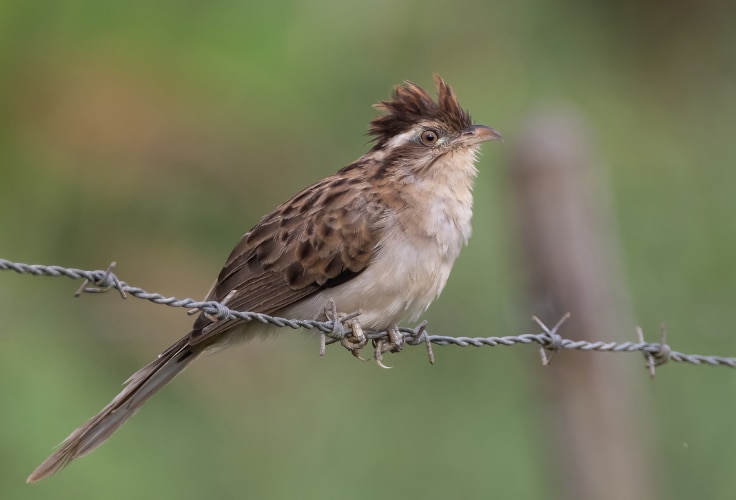
The striped cuckoo is unique among New World birds as one of only three parasitic cuckoos in the Americas. Widespread yet often unseen, it is more often heard than spotted thanks to its far-carrying, ventriloquial song that echoes across pastures and scrubby second growth. Its secretive habits and broad range, from Mexico to Argentina, have made it a subject of special interest in studies of brood parasitism beyond the Old World.
Like its Old World counterparts, this species leaves parental care to foster hosts. It targets mostly small suboscine songbirds that build domed or covered nests, with ovenbirds (Furnariidae) especially frequent victims. Other known hosts include tyrant-flycatchers, wrens, and sparrows. The cuckoo’s white or bluish eggs resemble those of its hosts. Incubation is slightly shorter than that of the host, giving the chick an early advantage. Once hatched, the nestling kills or ejects host young with its hooked bill, monopolizing the foster parents’ care. It grows rapidly, leaving the nest in just over two weeks but often remaining dependent for another two to three weeks.
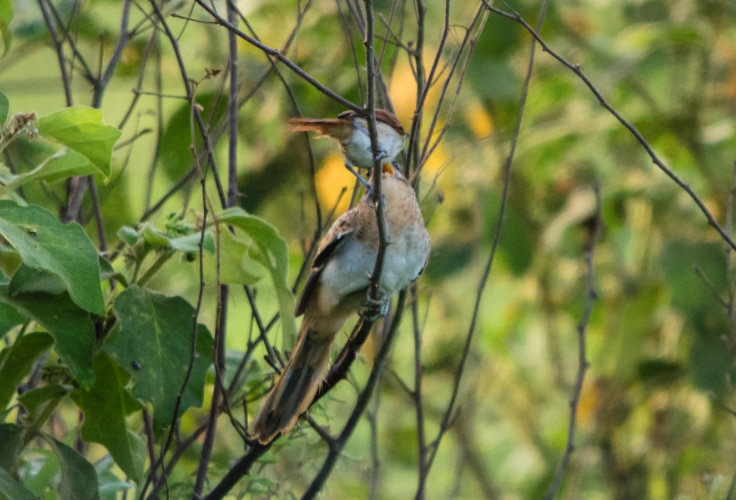
Hosts respond with varying success. Egg mimicry makes rejection difficult, and covered nests may limit adult detection of intrusions. Studies in Brazil show that parasitism rates can be high, with over a third of rufous-fronted thornbird nests affected in some seasons. In such cases, cuckoo nestlings display faster growth and higher survival than host chicks, underscoring the evolutionary pressure on hosts to refine defenses.
The striped cuckoo is distributed widely from southern Mexico and Central America southward to northern Argentina, inhabiting open landscapes with scattered trees, bushes, and thickets. It is generally considered fairly common throughout its range and faces no major conservation threats at present. Its adaptability, broad distribution, and reliance on unsuspecting small passerines make it an important representative of brood parasitism in the New World.
Costs and Benefits of Brood Parasitism
The species highlighted here stand out as the best-studied and most striking examples of brood parasitism in birds. They show the widest range of tactics, the most dramatic impacts on hosts, and in many cases have become model organisms for understanding how parasitism and host defense co-evolve.
Hosts are not passive victims. Some eject foreign eggs, others bury them under new nesting material, abandon parasitized clutches, or attack intruding females. Over time, these defenses shape the behavior of parasites in an evolutionary contest. The outcome is often mixed: in some nests the parasite succeeds completely, while in others hosts foil the intrusion.
Does brood parasitism really pay? For parasites, it frees them from the heavy costs of incubation and chick-rearing and allows them to lay far more eggs than normal. For hosts, the cost can be severe, from lost eggs to the complete failure of a brood. Yet many hosts persist, developing new defenses as parasites refine their tricks. Brood parasitism remains one of the most remarkable strategies in the bird world – a fragile balance between exploitation and resistance that continues to shape the lives of both parasite and host.

